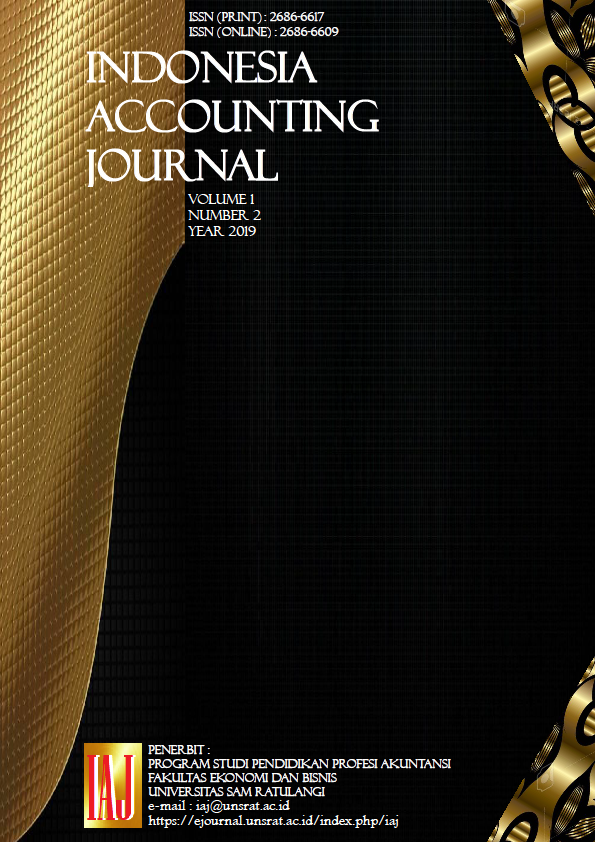Analisis penerapan PSAK No. 23 tentang pendapatan pada PT. Bintang Sayap Utama Cabang Indonesia Timur di Kota Manado
DOI:
https://doi.org/10.32400/iaj.26665Keywords:
recognition, measurement, disclosure, PSAK 23, revenueAbstract
Revenue increases the value of assets of a company's operational activities in accordance with applicable accounting principles. This guideline is a Statement of Accounting Standards (SFAS) No. 23 about income. In PSAK 23 there is a discussion on the recognition, measurement and disclosure of income that must be applied in accordance with the type and condition of the company. This study discusses the recognition and measurement of income from PT. Bintang Sayap Utama. This study uses descriptive qualitative by comparing the principles of recognition and measurement of income in PSAK 23 with the application by the company. The results of interviews and reviews of the company's financial statements indicate that the company has applied the concept of PSAK 23 on sales and income as well as on the price difference but not on the interest of income and other income. Based on this analysis, the application of recognition is revealed and the measurement of income at PT. Bintang Sayap Utama is not in accordance with PSAK 23 and it has been suggested to make corrections to the recording in which have found to not be appropriate.
References
Darsono & Ashari. (2014). Pedoman Praktis Memahami Laporan Keuangan. Cetakan Kedua. Yogyakarta: Penerbit Andi.
Fita, S. (2016). Analisis Kebijakan Pengakuan Pendapatan dan Beban Pada Perusahaan Daerah Rohul Jaya Kabupaten Rokan Hulu. Jurnal Mahasiswa Prodi Akuntansi Fakultas Ekonomi, 2(2). http://e-journal.upp.ac.id/index.php/akfekon/article/view/1050
Harahap, S. S. (2015). Analisis Kritis atas Laporan Keuangan. Jakarta: Rajagrafindo Persada.
Harrison, W. T., Horngren, C. T., Thomas, C. W., & Suwardy, T. (2012). Akuntansi Keuangan IFRS Edisi Kedelapan Jilid 1. Jakarta: Erlangga.
Hendriksen, S. E., & W. Nugroho. (2014). Teori Akuntansi. Edisi Keempat Jilid Satu. Jakarta: Erlangga.
Hery. (2017). Akuntansi Dasar 1 & 2. Jakarta: PT Grasindo.
Ikatan Akuntan Indonesia. (2015). Pernyataan Standar Akuntansi Nomor 23 Tentang Pendapatan. Jakarta: Ikatan Akuntansi Indonesia.
Isna, N. A. (2016). Analisis Pendapatan Atas Penjualan Angsuran Berdasarkan PSAK No. 23 Pada PT. Mahakam Berlian Samjaya Samarinda. Ekonomia, 5(3). http://ejurnal.untag-smd.ac.id/index.php/EKM/article/view/2108
Kieso, D. E., J. J. Weygandt dan T. D. Warfield. (2012). Intermediate Accounting. Edisi Kedua Belas. Jakarta: Erlangga.
Pontoh, W. (2013). Akuntansi Konsep dan Aplikasi. Jakarta: Halaman Moeka.
Rosalie, E., & Budiarso, N. S. (2017). Analisis pengakuan pendapatan dan beban menurut PSAK No. 28 pada PT. Asuransi Tri Pakarta Cabang Manado. Jurnal Accountability, 06(01), 1-91. https://doi.org/10.32400/ja.16030.6.1.2017.81-91
Santoso, I. (2015). Akuntansi Keuangan Menengah (Intermediate Accounting). Buku Satu. Bangung: Refika Aditama.
Stice, J. D., E. K. Stice., F. Skousen. (2016). Akuntansi Keuangan Menengah. Edisi 16 Buku 2. Edisi Bahasa Indonesia. Terjemahan Oleh Ali Akbar. Jakarta: Salemba Empat.
Synthia, M. (2014). Analisis Pengakuan dan Pengukuran Pendapatan Berdasarkan PSAK No. 23 Pada PT. Pandu Siwi Sentosa Palembang. http://eprints.mdp.ac.id/1160/
Tuanakotta, T. (2015). Audit Kontemporer. Jakarta: Salemba Empat.
Downloads
Additional Files
Published
Issue
Section
License
The articles published in Indonesia Accounting Journal are licensed under Creative Commons Attribution 4.0 International License with authors as copyright holders.
Â

This work is licensed under a Creative Commons Attribution 4.0 International License.
Â
Under this license then authors free to:
- Share — copy and redistribute the material in any medium or format.
- Adapt — remix, transform, and build upon the material for any purpose, even commercially.
Under the following terms :
- Attribution — You must give appropriate credit, provide a link to the license, and indicate if changes were made. You may do so in any reasonable manner, but not in any way that suggests the licensor endorses you or your use.
- No additional restrictions — You may not apply legal terms or technological measures that legally restrict others from doing anything the license permits.
Notices:
- You do not have to comply with the license for elements of the material in the public domain or where your use is permitted by an applicable exception or limitation.
- No warranties are given. The license may not give you all of the permissions necessary for your intended use. For example, other rights such as publicity, privacy, or moral rights may limit how you use the material.


